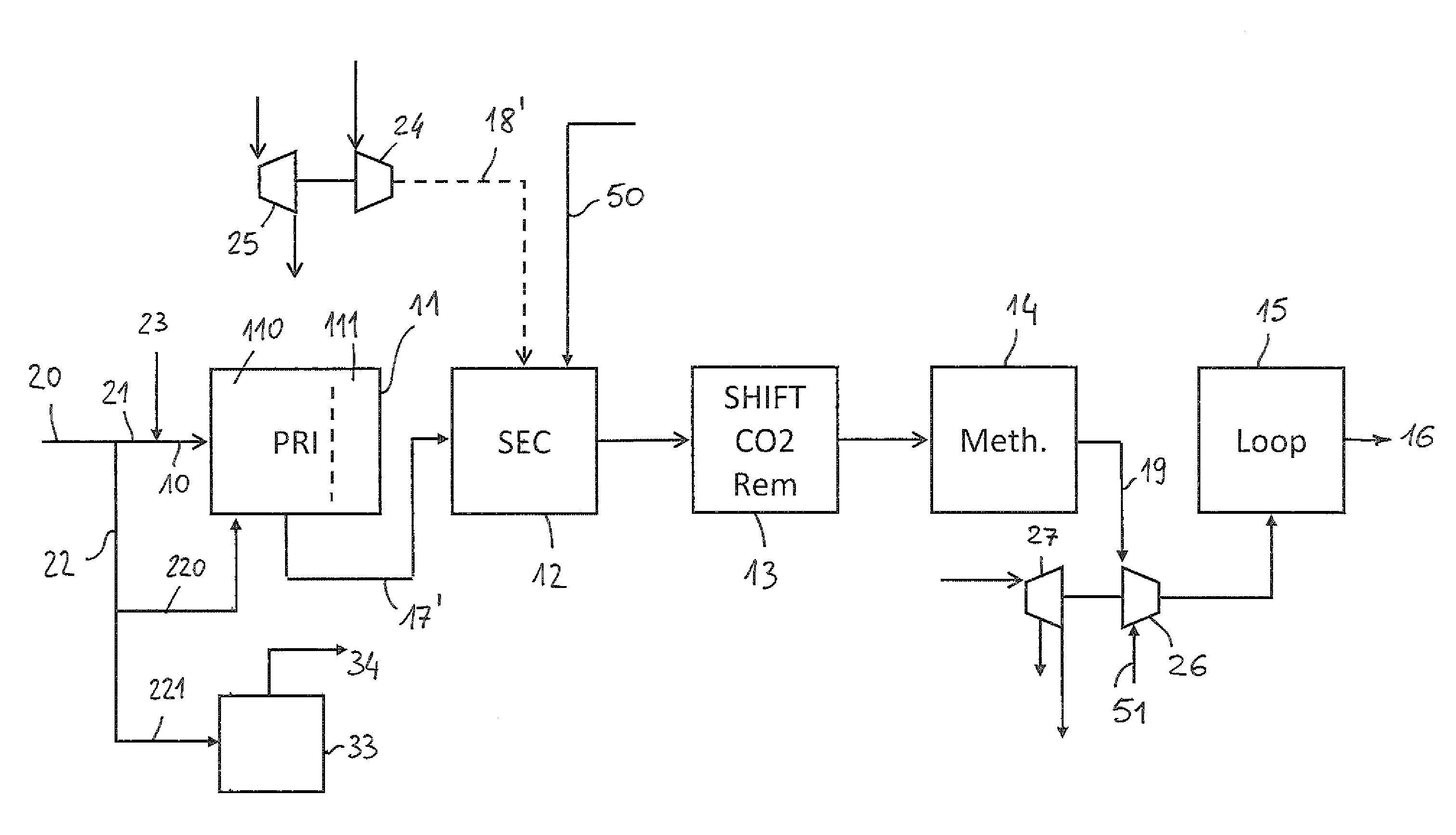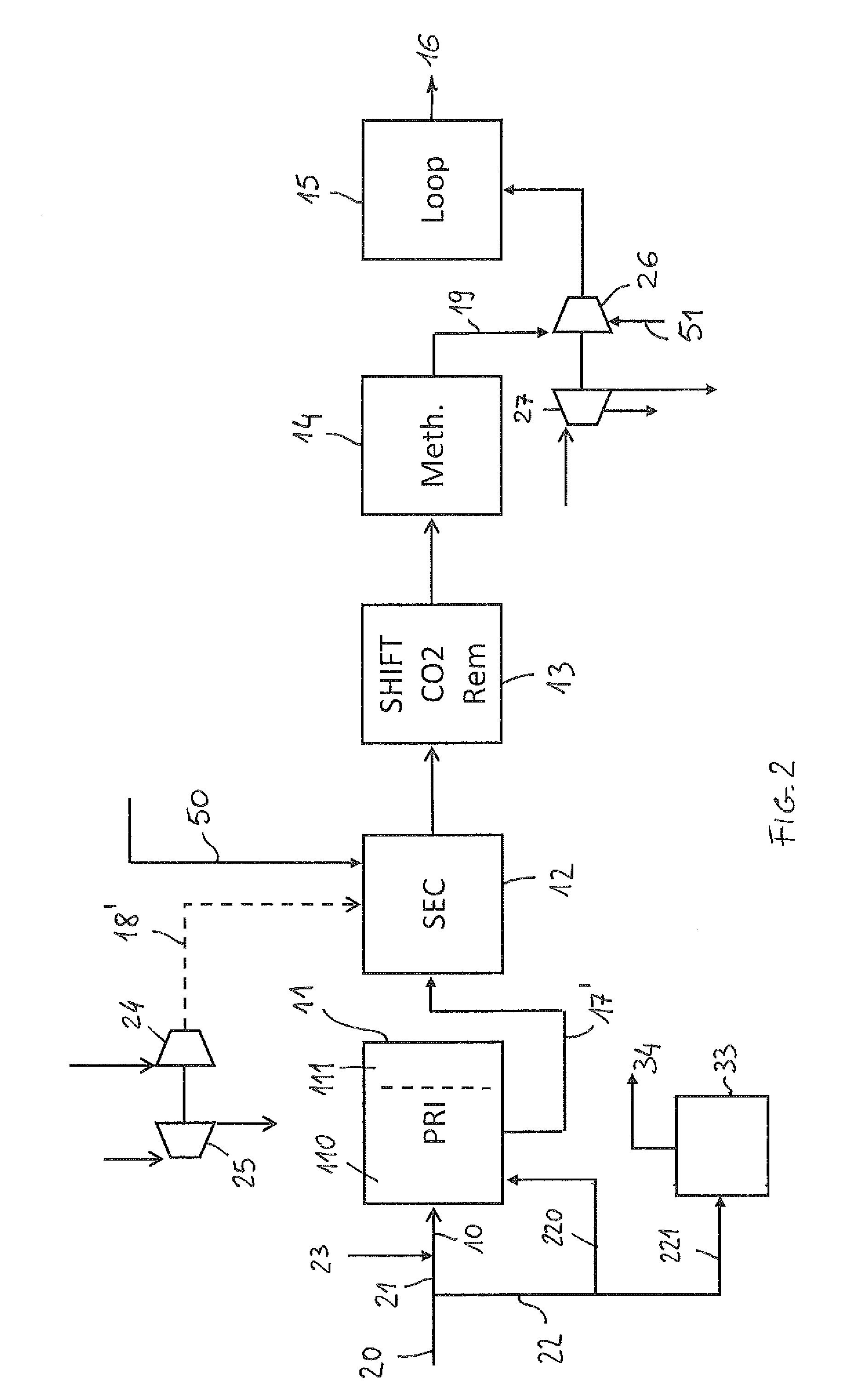Method of revamping of an ammonia plant fed with natural gas
a technology of natural gas and ammonia plants, which is applied in the field of ammonia plant revamping, can solve the problems of unsatisfactory methods, limited quantity of natural gas available for ammonia plants, and mainly on obtaining the highest possible capacity, so as to achieve less expensive, increase capacity, and increase the effect of capacity
- Summary
- Abstract
- Description
- Claims
- Application Information
AI Technical Summary
Benefits of technology
Problems solved by technology
Method used
Image
Examples
example 1
[0068]The following table 1 refers to a first example of application of the invention.
[0069]A conventional plant according to FIG. 1 is fed exclusively with natural gas and has a total consumption of 8.0 Gcal / t of ammonia, based on the LHV of natural gas. Such consumption is divided as follows:
[0070]process feed gas (21): 5.4 Gcal / t (67.5%);
[0071]fuel gas (22): 2.6 Gcal / t (32.5%).
[0072]The consumption of fuel gas comprises the fuel of the reformer (radiant and convective) and fuel of an auxiliary burner to produce the steam necessary to operation. For a production of 1500 MTD of ammonia, the total consumption of natural gas (flow 20) comes to 2629 kmol / h.
[0073]In an embodiment indicated as “A”, the plant is revamped with the following basic interventions:[0074]injection of oxygen (flow 50) into the secondary reformer 12 in place of air,[0075]injection of a nitrogen flow 51;[0076]reduction of the duty of the primary reformer 11 and consequent lowering of the outlet temperature of sai...
example 2
[0085]A plant is modified according to the previous Example 1. In addition, all the machines of the ammonia plant with the exception of the syngas compressor, originally powered by steam turbines, are modified to use electric motors. The consumption of fuel gas is therefore further reduced. This variant is shown in table 2 as variant “B”.
[0086]It is compared with a modification indicated as “D” that is equivalent to the modification “C” described above and also comprises:[0087]electric motors as drivers for the machines normally powered by steam turbines[0088]increase by 12% of the capacity of the steam reformer 11 and 7% increase of radiant efficiency by introducing an air preheater.
[0089]
TABLE 2DBASEB(PRIOR ART)Ammonia Productiont / d150017951680Variation120%112%Specific consumptionGcal / t8.016.697.15(FEED + FUEL), LHVConsumption FEEDGcal / t5.416.035.41Consumption FUELGcal / t2.590.661.74Total consumption of gaskmol / h262926292629Flow rate of process airt / h70.0078.4Primary reformer DutyG...
PUM
| Property | Measurement | Unit |
|---|---|---|
| temperature | aaaaa | aaaaa |
| temperature | aaaaa | aaaaa |
| temperature | aaaaa | aaaaa |
Abstract
Description
Claims
Application Information
 Login to View More
Login to View More - R&D
- Intellectual Property
- Life Sciences
- Materials
- Tech Scout
- Unparalleled Data Quality
- Higher Quality Content
- 60% Fewer Hallucinations
Browse by: Latest US Patents, China's latest patents, Technical Efficacy Thesaurus, Application Domain, Technology Topic, Popular Technical Reports.
© 2025 PatSnap. All rights reserved.Legal|Privacy policy|Modern Slavery Act Transparency Statement|Sitemap|About US| Contact US: help@patsnap.com



